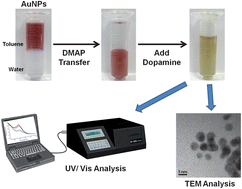Novel core etching technique of gold nanoparticles for colorimetric dopamine detection†
Abstract
This study develops a novel and high performance colorimetric probe for

* Corresponding authors
a
Department of Mechanical and Electro-Mechanical Engineering, National Sun Yat-sen University, Kaohsiung 804, Taiwan
E-mail:
chehsin@mail.nsysu.edu.tw
Fax: +886-7-5254299
Tel: +886-7-5254240
b Department of Chemistry, National Sun Yat-sen University, Kaohsiung 804, Taiwan
This study develops a novel and high performance colorimetric probe for

 Please wait while we load your content...
Something went wrong. Try again?
Please wait while we load your content...
Something went wrong. Try again?
H. Lee, T. Chen, W. Tseng and C. Lin, Analyst, 2012, 137, 5352 DOI: 10.1039/C2AN35586H
To request permission to reproduce material from this article, please go to the Copyright Clearance Center request page.
If you are an author contributing to an RSC publication, you do not need to request permission provided correct acknowledgement is given.
If you are the author of this article, you do not need to request permission to reproduce figures and diagrams provided correct acknowledgement is given. If you want to reproduce the whole article in a third-party publication (excluding your thesis/dissertation for which permission is not required) please go to the Copyright Clearance Center request page.
Read more about how to correctly acknowledge RSC content.
 Fetching data from CrossRef.
Fetching data from CrossRef.
This may take some time to load.
Loading related content
